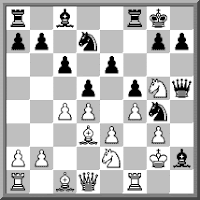Dealing with transpositional options is an eternal challenge for repertoire books. A good repertoire may well be inconsistent if you in a certain position have a choice between a move X that will lead to a position you have to face anyway (by transposition) and a move Y which may be better but takes some effort to analyse. Going for move X is rational as it saves you some labour but in chess your first priority should be to play the best move.
Whether you should go for the independent option (Y) or not, must depend on at least three factors:
- How satisfied are you with the positions resulting from move X?
- How much better can move Y really be?
- How complicated are the variations following move Y?
 Here we mention 7.b3 Qe7 and now:
Here we mention 7.b3 Qe7 and now:- 8.Bb2 (when play may continue 8...b6 9.Ne5) and
- 8.Ne5 (when 8...0-0 9.Bb2 b6 is a possibility).
However, there also is a related possibility:
- 7.Ne5 0-0 8.b3!? (when 8...Qe7 9.Bb2 b6 transposes to the lines above).
We agree that this is a natural move, and although it is very rare and not tested in high-level encounters, it deserved a mention. An author should not only look at what has been played by strong players but also scan the position for other 'normal looking moves', trying to foresee what his readers may wonder at.
The anonymous reader concludes that in order to have a consistent repertoire against all of White's various combinations of b3 and Ne5, it's necessary to play ...b6 lines against all of them. I disagree with that conclusion. A completely ...b6 based solution is certainly possible, and fully recommended if you trust your analysis after 7.b3 Qe7 8.Ne5 0-0 9.Bb2 b6!? 10.cxd5 exd5. However, this line is based on untested analysis and it's also possible to meet each of the three lines with a specific reply, even if only one of them involves an early ...b6:
a) 7.b3 Qe7 8.Bb2 b6 9.Ne5 Bb7! which has for a long time been considered fine for Black.
b) 7.b3 Qe7 8.Ne5 0-0 9.Bb2 Nbd7!? planning ...a5 (as Moskalenko does).
c) 7.Ne5 0-0 8.b3 Nbd7(!), securing an edge in development and planning ...dxc4 followed ...e5.
As a matter of fact, even if I am tempted to go for the ...b6 solutions, against line c) I would seriously consider 8...Nbd7 as it seems strategically simpler.
Lessons to be learned
- Being 'too consistent' - trying to transpose whenever possible - may cost you some advantageous options.
- Transpositions rarely are just transpositions; normally there is a trade of options. You stop some options and allow others.







